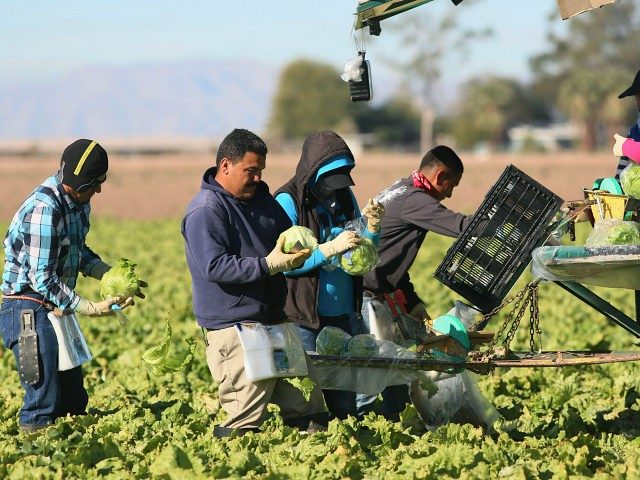ONE-THIRD OF ALL
ILLEGAL "cheap" LABOR
FARM WORKERS END UP
ON WELFARE AS SOON AS
THEY START PUTTING OUT
ANCHOR BABIES. ALL VOTE
DEMOCRAT FOR MORE!
Study: More than 7-in-10 California Immigrant
Welfare
More than 7-in-10 households headed by immigrants in the
state of California are on taxpayer-funded welfare, a new study reveals.
The latest Census Bureau data analyzed by the Center for Immigration Studies (CIS) finds that
about 72 percent of households headed by noncitizens and immigrants use one or
more forms of taxpayer-funded welfare programs in California — the number one
immigrant-receiving state in the U.S.
Meanwhile, only about 35 percent of households headed by
native-born Americans use welfare in California.
All four states with the largest foreign-born populations,
including California, have extremely high use of welfare by immigrant
households. In Texas, for example, nearly 70 percent of households headed by
immigrants use taxpayer-funded welfare. Meanwhile, only about 35 percent of
native-born households in Texas are on welfare.
In New York and Florida, a majority of households headed by
immigrants and noncitizens are on welfare. Overall, about 63 percent of
immigrant households use welfare while only 35 percent of native-born
households use welfare.
President Trump’s administration is looking to soon implement a
policy that protects American taxpayers’ dollars from funding the
mass importation of welfare-dependent foreign nationals by enforcing a “public
charge” rule whereby legal immigrants would be less likely to secure a
permanent residency in the U.S. if they have used any forms of welfare in the
past, including using Obamacare, food stamps, and public housing.
The immigration controls would be a boon for American taxpayers
in the form of an annual $57.4
billion tax cut — the amount taxpayers spend every year on paying for
the welfare, crime, and schooling costs of the country’s mass importation of
1.5 million new, mostly low-skilled legal immigrants.
As Breitbart News reported, the majority of
the more than 1.5 million foreign nationals entering the country every
year use about 57
percent more food stamps than the average native-born American
household. Overall, immigrant households consume 33 percent more cash
welfare than American citizen households and 44 percent more in Medicaid
dollars. This straining of public services by a booming 44 million foreign-born
population translates to the average immigrant household costing American
taxpayers $6,234 in federal
welfare.
Report: Crammed Working Conditions for H-2A Foreign Workers Pose Public Health Risk

4:23
The often crammed working and living conditions that imported foreign farmworkers are exposed to pose a particular public health risk during the Chinese coronavirus crisis, experts say.
While jobless claims for Americans have spiked beyond 6.6 million in just a week, the State Department announced new visa waivers for H-2A and H-2B foreign agricultural and nonagricultural workers, making it all the easier for businesses to import cheap foreign labor.
For H-2A foreign visa workers — the program by which big agriculture imports hundreds of thousands of farmworkers every year — working and living conditions are tight, an issue amid mandatory social distancing standards issued by the Center for Disease Control (CDC).
Labor laws demand that employers of H-2A foreign visa workers provide their imported workforce with housing, which often means nationals from across Central America live in close living quarters together.
Experts with the Economic Policy Institute (EPI) note in new research that H-2A foreign farmworkers will be at risk of contracting and spreading the coronavirus due to these close working and living conditions should employers not change their practices.
“The most important thing farm employers should do now is devise safety plans and procedures and procure additional safety and sanitation equipment,” EPI researchers Daniel Costa and Philip Martin write. “In order to keep healthy, farmworkers need access to masks, gloves, and other safety equipment, as well as ways to disinfect their hands, tools, clothing, and machinery.”
EPI researchers continue:
Employers may need to implement “social distancing” measures in fields and packing facilities to minimize the risk of farmworkers infecting one another. This will require changes in workplace habits that may be uncomfortable for workers and may reduce productivity if, for example, crews that work conveyor belts in vegetable fields are shrunk to avoid close contact. [Emphasis added]Employers should encourage farmworkers to report when they feel ill and to stay home if they are sick, and not punish them for it. If workers think they will be disciplined, have their hours cut, or be fired, they may work sick, endangering their colleagues. Some Mexican exporters are reportedly checking the temperatures of their workers and barring visitors, fearing that a COVID-19 case could prevent them from exporting produce to the United States. [Emphasis added]
Left-wing organizations representing foreign farmworkers have told the media that they have serious reservations about the working and living conditions in the midst of much-needed social distancing measures to stop the spread of the coronavirus.
These spokespersons also said big agriculture’s push to pack farms with as many H-2A foreign visa workers this year amid the crisis could mean more working and living condition violations.
“We’re really concerned, especially given that a lot of them live in bunker-style housing,” a spokesperson with the left-wing Central Coast Alliance United for a Sustainable Economy group told the Santa Maria Sun.
“We are really concerned that in this emergency situation we’re going to … see an increase in housing violations by overcrowding,” another spokesperson with a left-wing advocacy group said. “There are not going to be adequate measures taken to ensure that workers can social distance, either at the housing or in the surrounding areas.”
While H-2A foreign visa workers earn well above the $7.25 an hour federal minimum wage, farmers routinely use the program to reduce wages in the agricultural industry, the Bureau of Labor Statistics data has shown.
In 2017, H-2A foreign visa workers picking crops were paid about two percent less than their American counterparts, while visa workers operating agricultural equipment were paid 23 percent less than the national average wage for that job. The largest wage discrepancy comes with H-2A foreign visa workers who take jobs as first-line supervisors for farming and fishing. They are paid about 95 percent less than their American counterparts.
John Binder is a reporter for Breitbart News. Follow him on Twitter at @JxhnBinde
Unemployment Rate Jumps to 4.4%, 701,000 Jobs Lost

4:29
The unemployment rate jumped to 4.4 percent in March and the economy shed 701,000 jobs.
The new numbers from the Department of Labor’s employment situation report end the record 113 straight months run of hiring.
Employment in leisure and hospitality businesses fell by 459,000, with a loss of 417,000 of jobs in bars and restaurants. That’s enough to erase two years of gains.
Economists had forecast that the government would say employers shed about 150,000 jobs and that the unemployment rate rose from a half-century low of 3.5 percent to 3.9 percent, according to FactSet.
Health care employment declined by 43,000, as people put off elective medical procedures and even regular check-ups. Dentist offices lost 17,000 jobs, physician office lost 12,000 jobs, and other health care practitioners lost 7,000 jobs.
In March, social assistance saw an employment decline of 19,000, reflecting a 19,000 job loss in child daycare services.
Employment in professional and business services decreased by 52,000 in March, with temporary help services falling by 50,000. Employment also decreased in travel arrangement and reservation services by 7,000.
Retail trade declined by 46,000 jobs. Clothing and clothing accessories stores jobs shrank by 16,000, furniture store jobs fell by 10,000, and jobs in sporting goods, hobby, book, and music stories fell by 9,000.
In a demonstration of just how widespread the jobs losses have been, employment fell by 30,000 in construction, including an 11,000 job loss in heavy construction and civil engineering.
In March, manufacturing employment slipped by 18,000. Growth in manufacturing employment stagnated last year and is more or less unchanged from a year ago. Personal and laundry services dropped by 13,000.
But the jobs figures vastly understate the magnitude of last month’s losses because the government surveyed employers before the heaviest layoffs struck in the past two weeks. Nearly 10 million Americans have since applied for unemployment benefits, far more than for any corresponding period on record.
The higher than expected jobs loss and unemployment figures for March indicate that, some job cuts happened earlier in the month, when most economists think businesses began clamping down on hiring. The job loss for March underscore the head-snapping speed with which the economy has unraveled after nearly a decade in which employers added nearly 23 million jobs. As recently as February, employers added 273,000 jobs.
Economists had welcomed February’s job gain, though they wondered why hourly paychecks weren’t rising more quickly. But any concerns over sluggish wage growth have now been put well off to the side.
“Four years of job gains have evaporated in the span of two weeks,” said Daniel Zhao, an economist at the jobs website Glassdoor.
The layoffs will continue to mount. Some economists have forecast that 20 million jobs will be lost by the end of April, swelling the unemployment rate as high as 15% and wiping out the bulk of the past decade’s gains. That unemployment rate would be the worst since the 1930s.
Roughly 90 percent of the U.S. population is living under some version of a shutdown order, which has forced the closure of bars, restaurants, movie theaters, factories, gyms and most other businesses. Some hotels are closed; others are largely empty. Fast-food chains are either closed or providing only drive-through service, costing thousands of jobs.
With business activity tightly restricted, analysts expect a stomach-churning recession. Economists at Goldman Sachs have forecast that the economy will shrink at an annual rate of 34 percent in the April-June quarter — the worse fall on records dating to World War II. Goldman expects the economy to rebound with 19 percent growth in the third quarter. But even by the end of next year, the economy will not have fully recovered from the damage, Goldman projects.
–The Associated Press contributed to this report
No comments:
Post a Comment